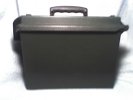|
I'm not going to say its possible or not as I have not ever had one of these cards in my hands. The online quick datasheet is a little iffy on if it supports Adhoc mode, but assuming it does, it is an ath5k device which means Linux supports it and that you can build up a computer to run the BBHN protocol across it (Adhoc, OLSRD, etc) but no build exists for it at this time (and it would be hard to make a dedicated build for it as it is a PCI card that can slip into any computer) But assuming adhoc mode one should be able to do it I don't see why not.
The next question that crosses my mind is Part 97 licensing on the subject, I'm not going to render an opinion, I'm just going to say I'm not sure if its permitted or not as I've read conflicting information, enough to make me feel to say it needs to be researched more.
I will say i would LIKE it to be permitted as that can clear up some of the NLOS issues possibly better than the 900mhz band does and may open more options.
The parts I believe to be the relevent text from Part 97 is as follows for authorized transmissions on 70cm
97.307(6) A RTTY, data or multiplexed emission using a specified digital code listed in § 97.309(a) of this part may be transmitted. The symbol rate must not exceed 56 kilobauds. A RTTY, data or multiplexed emission using an unspecified digital code under the limitations listed in § 97.309(b) of this part also may be transmitted. The authorized band-width is 100 kHz
(8) A RTTY or data emission having designators with A, B, C, D, E, F, G, H, J or R as the first symbol; 1, 2, 7 or 9 as the second symbol; and D or W as the third symbol is also authorized.
OFDM (802.11g) from what I can find is designator: 16M8GXW
Ive read one article but I haven't found a reputable reference for its claims other than an opinion that the 'bandwith" rule applies to each carrier (and I'm not even sure how big each subcarrier of an 802.11 signal is)
I've seen some argument brought on by the Google WIFI case to argue that each subcarrier is unique and independent (and that the receiving of all of them at once was special equipment) to possibly give this some merit, but not enough that I would personally say if its permitted or not. I also saw another document try and argue it was "image" not "data" because you could put video across it, not sure I would suggest that as a valid interpretation either considering how the mesh normally functions.
Of course if you could some how lock them to the low 1mb speed (not sure if it can be done off hand or not) one could claim they are Spread Spectrum (which I'm not sure is or is not subject to the data restriction or not)
I would suggest researching those items . I can say If i managed to stumble upon some of those boards at an affordable price I could see them being useful and would love to press them into service if its permissible.
So there you have my thoughts on it, I don't know enough to give an opinion one way or the other on the licensing side, only enough to say I have questions.
Otherwise from a technical standpoint, if they support adhoc mode they would be likely physically capable of being put into service.
|
